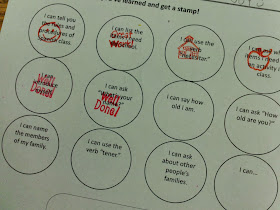My funny voices started in Japan. I wanted my students to practice questions and answers in English. Since I spoke little to no Japanese I had to act out what I wanted them to do. They also happened to sit boy/girl/boy/girl there so when I acted out the students having the conversation with the person next to them one naturally had a very deep voice and the other a very high voice. One day I acted it out without the voices and I got a very upset little 3rd grader who said, "sensei, sensei blah blah blah" which I translated as "Teacher, where are the silly voices?"
I use the same strategy in my Spanish classes when I want the kids to practice questions and answers during our Enseña period. And since we´ve started doing descriptions in 4th and 5th grade they have become invaluable when learning that gender agreement in our ajectives - Yo soy delgada said in a high pitched voice versus Yo soy delgado said in a deep voice. Do the students think I´m crazy? Yes. Are they having fun? Yes. Are they learning the difference between femenine and masculine adjectives? Yes.
Funny voices are also great for anything that require repetition. So when I'm introducing new vocabulary we say it quiet, loud, high-pitched, low-pitched, angry, sad, like robots etc. Let the students give you ideas. This past week in my after school enrichment program we sang Cabeza, Brazos, Piernas, Pies (or Head, Shoulders, Knees and Toes) many many different ways, my favorite being as old men with canes and Tyrannosaurus Rexes, both student suggestions. As dinosaurs we roared after each verse and as old men we groaned when we couldn't reach our toes. I was almost in tears from laughing by the end.
Do you use funny voices in your classes? How and when? Share in the comments below!



